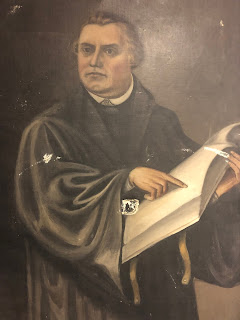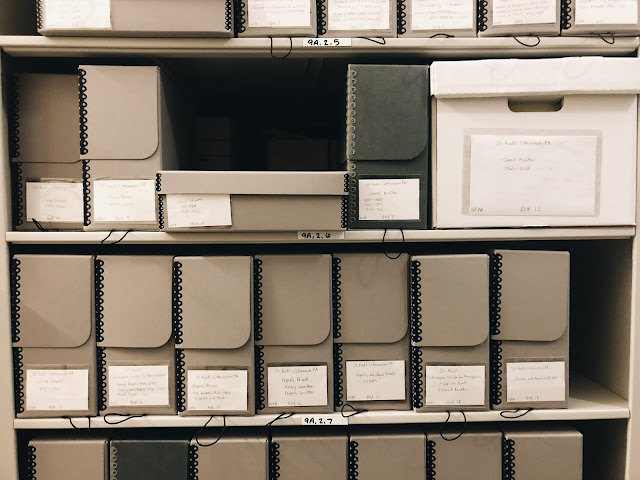Don’t Judge a Book by Its Cover? | Learn About Book Bindings Through the MOP Collection!
To an outsider, a book’s cover would just seem like a functional or aesthetic aspect of a book. While this is not wrong, book bindings are an important aspect of the rare book and archives world. The history of book bindings is vast and very fascinating, and you could definitely spend hours exploring this field of study. Today, we hope to provide you with an introduction to aspects of book binding as found within the Lutheran Archives’ Ministerium of Pennsylvania (MOP) collection.
1. Basic Terminology
Before jumping into more decorative aspects of book bindings, it is useful to discuss some technical aspects of books. So, all covered books have these aspects: text block, cover, and spine.
 |
| A15.08 1 BS |
As expected, the text block refers to the pages of a book, where all the content, or text, is held. In most cases, as in the case of the MOP collection, this is the primary reason why a book is deemed worthy of preservation.
The covers, then, provide initial protection to the text block, but can also warrant protection in their own right depending on how old or ornate they are. In the rare book world, the front cover is known as the upper, while the back cover is known as the lower; this is to prevent confusion as the term ‘back’ has a different meaning in the rare book world than it’s everyday use.
And finally is the spine. Also known as the back of the book, it is the covered edge of the text block which allows protection for the collated (usually be sewing) leaf gatherings as the book is being read or consulted.
 |
| D52 1902-65 v.1 |
The text block, covers, and spine all then have a head, the top of the book, and a tail, the bottom of the book. The text block also has three edges: the head and tail, as well as the fore-edge, which is the edge opposite the spine.
2. Materials
Bindings can come in a variety of materials and colors, and can have various decorative features, as seen by these books held within the Ministerium of Pennsylvania collection. Bindings can be made of leather, cloth, or paper, the first two of which have a variety of sub-categories.
 |
| D6.01 E5 1892-93 |
 |
| H10 F85L9 A v. 1 |
3. Decorations
When it comes to cloth and paper bindings, there isn’t really much that can be done in terms of decoration apart from the colors used. Leather bindings, however, are a little more interesting in terms of designs. In fact, leather can be incorporated into bindings that have cloth or paper covers in order to allow for more decorative aspects to be incorporated.
Because the spine is usually the first part of a book to be seen when on a bookshelf, it is no surprise that it is usually the most decorated. Spines could have panels (rectangular sections usually made of a different colored leather or altogether different material), lettering-pieces (panels with text), and raised bands (protruding ridges). But these are not the only decorations available to book spines.
 |
| A23 v. 7-14 |
Design elements common to both the spine and covers are tooling (impressed designs which can be blind, or plain, as well as gilded, or filled in with gold), and other border-designs, as well as inlays and overlays (these two elements are when different colors of leather are inserted into or over the main leather of the cover).
These latter decorative aspects are used in mosaic bindings, which are evident in two of the books shown here. While spines and covers are definitely the parts of books that are most commonly decorated, the text block is not devoid of decoration.
Most obvious are gilded edges, where the edges of the text block are coated in gold.
 |
| fH10 N86T8 S v. 3 1889-1896 |
We hope you enjoyed learning more about book bindings! What was your favorite cover included in this post?
Do you have a favorite book binding-related aspect that wasn’t mentioned? We’d love to hear your thoughts!
Stay tuned for more book terminology and other aspects of the rare book world, as we hope to do more in the future. If you’ve got a request for other in-depth book-related content, please let us know!
For more information about book bindings, we recommend checking out these sources:
ABC For Book Collectors (8th Edition) by John Carter & Nicholas Barker
Wikipedia’s entries on Bookbinding and Book Covers
iBookBinding’s blog post on Bookbinding History and Introduction
Photos of featured books from MOP Collection
1- A15.08 1 BS: Ev. Luth. Ministerium of Pa. & Adj. States President Account Book
2- A23 v. 7-14: The Ministerium at Work vol. VII-XIV 1932-1939
3- D6.01 E5 1892-93: Minutes Second District Conference of Synod of Penn.
4- fH10 N86T8 S v. 3 1889-1896: Minutes (of church council & annual congregational meetings)
5- D52 1902-65 v.1: Minutes (of Eastern Berks Lutheran Pastoral Association)
6- H10 F85L9 A v. 1: The Evangelical Lutheran Church- Frederick, Frederick County, MD. Book I 1743-1811 (Parish records)


Comments
Post a Comment